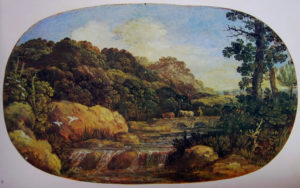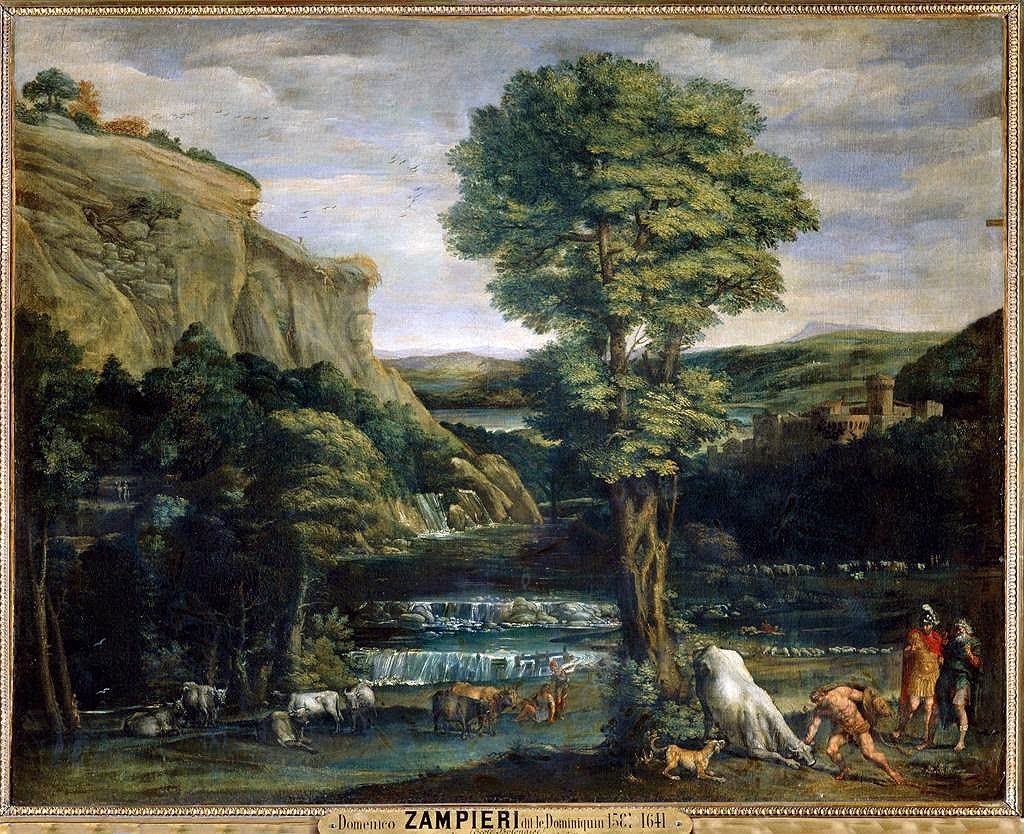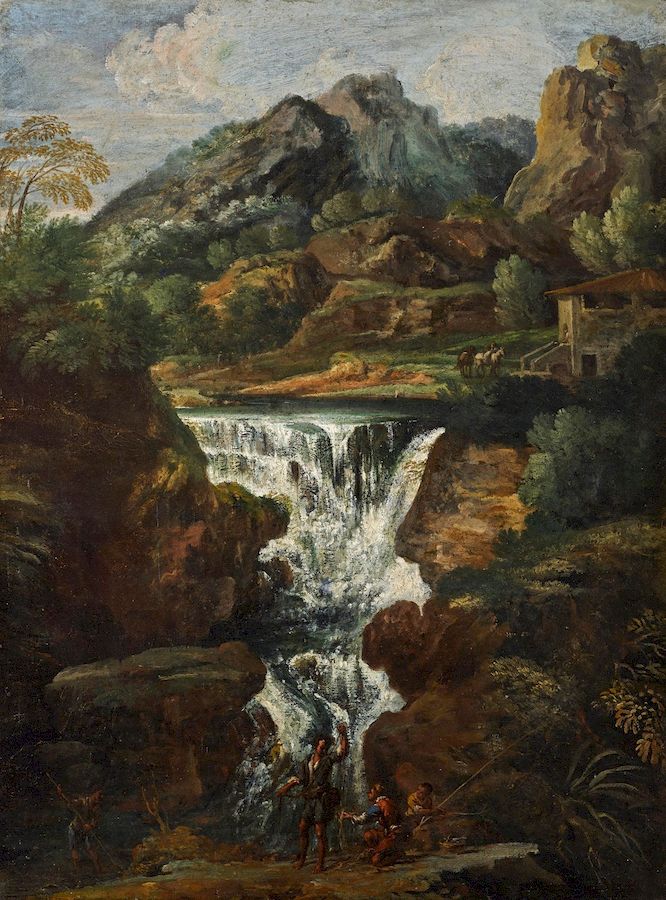di Erich SCHLEIER
Pietro Berrettini, called Pietro da Cortona
(Cortona 1596 – Rome 1669)
Mountainous landscape with a waterfall (cascade), falling from a lake, with a farmhouse and figures on the foot of the waterfall, in the foreground. Oil on canvas, 66 x 49 cm.
I examined this unpublished painting directly on February 27 2018. The picture had recently been cleaned and is in good condition. In my opinion [and in the opinion of some other scholars (the same opinion expressed writing by prof. Nicholas Turner. NdA)] this landscape, which had been formerly ascribed wrongly to the circle of Gaspard Dughet, is a relatively youthful work of Pietro da Cortona and can be connected with a small group of landscapes, a few easel paintings (and some frescoes in the chapel of the Villa Sacchetti at Castelfusano) and some drawings, which Cortona did early in his career, in the Twenties and probably in the early Thirties.[i]

The landscape paintings by Cortona, which are most closely related and comparable, are the two very small paintings of elliptic horizontal format (17 x 28 cm, 16 x 27 cm), painted on wood, in the Capitoline Gallery in Rome: a coastal landscape with a Villa (Palace), a castle, boats and ships, and a hilly wooded landscape with a waterfall and a bridge, on which we see two horses followed by a man,[ii] both painted for Cortona’s early patrons, the Sacchetti brothers, and the somewhat larger, almost square painting of a landscape with the alum mines at Tolfa, a small town near Civitavecchia north of Rome, painted also for the Sacchetti, according to Guarino at the beginning of the forth decade. [iii]
Of the two small pictures, of course the landscape with the waterfall and the bridge lends itself more than the coastal view. Both the landscape with the waterfall and the landscape with alum mines of Tolfa show tiny standing figures, those in the Tolfa picture are unlit, in the shade, quite similar to the somewhat larger figures, but equally in the dark, unlit, in our present picture.
The picture with the waterfall in the Capitoline Gallery shows the influence of landscape paintings by Pietro Paolo Bonzi, for instance two small landscapes of elliptic horizontal format in the Galleria Doria Pamphilj, of ca. 1615 – 25. [iv] Cortona had worked aside with Bonzi in working on the frescoes of the Galleria in the Palazzo Mattei (1622-23).. Many of Bonzi’s landscape paintings show a strong affinity with Agostino Tassi (with whose works they were often confused), whereas there is hardly any Tassi influence in the Capitoline landscapes and in the present picture by Cortona. With the more freely painted Tolfa painting, stylistically and conceptually a unique picture, our picture has in common the handling of the rocky hills in sunshine, quite loosely painted with a dry brush (in the upper right corner of our picture) and the remarkable, boldly painted rocks in the Tolfa picture. Besides, the size of the Tolfa picture (61 x 75 cm, although horizontal) is quite similar to that of our picture.
The motif of the waterfall, the central and domineering feature in our picture, beside the rocky formations of the hills and mountains in the background and on the side, are also prominently represented in three closely related drawings by Cortona, two highly finished drawings formerly at Holkham Hall, coll. Earl of Leicester, sold at auction in 1991 [v] and a further drawing, of a hilly landscape with two cascades and two small farmhouses or cottages, quite similar to the one in our picture. This drawing,[vi] more informally and sketchily executed in brown ink and wash, shows only the right part of the lunette shaped landscape composition. It has in common with our picture, beside the waterfall and the houses, the tightly shaped bushes or low trees, furthermore the rather high viewpoint or eye-point, which is most characteristic in our picture, where the viewer’s eye meets the upper part of the waterfall and the lake, from which the cascade stems, while the lower part of the picture with the figures at the foot of the waterfall are seen from a birds-eye’s view. This is not true for the two ex Holkham drawings, which have classically conceived compositions, but the lake and the waterfall in the centre of the composition and the towering mountain with tightly formed bushes and small trees (in the one drawing (sale no. 28) )which almost reach the upper edge of the composition, are features which are quite comparable and similar to those in our picture. Both ex Holkham drawings date from the later Twenties, from the time of the frescoes in the Villa Sacchetti in Castelfusano, according to Chiarini (1972)[vii] and Merz (1991).[viii] A similar cascade in the middle o the vertical composition, the high horizon and rocks and large trees with rich foliage can be found also in the vertical fresco with the “Flight into Egypt” in the chapel of the Casino of the Villa Sacchetti in Castefusano of 1626-29.[ix]
The waterfall the cascade, is the central motif and feature in our picture. But the high horizon, th birdseye view and the treatment of the woody, rocky hills are equally important. This motif can be seen in one of the two small ex Sacchetti, now Capitoline pictures, in one of the two Holkham drawings , in the drawing sold in New York in 1992 and in our picture. It seems as if Cortona at that time was almost obsessed with this motif. But he was by no means the only one to use this motif. A prominent example is Domenichino’s large “landscape with Hercules and Achelous” in the Louvre ( 121 x 149 cm, 
thus larger than tela d’ imperatore), painted in 1622-23 ca. for Ludovico Ludovisi in Rome, during the short pontificate of Gregory XV Ludovisi. [x] In its classical conception and in its large size it is quite different, but the cascades, the high horizon, the rocky formations on the left reaching very high, and the partially birdseye view are elements that can be compared with our picture. It is not impossible, that the young Cortona, who at that time was involved in the decoration of the gallery of the Palazzo Mattei, saw the picture in Domenichino’s studio and was impressed by it.
Yet the inner monumentality of our picture, despite the modest size, with the wooded mountains reaching almost to the upper border and leaving little space for the cloudy sky, are elements that make this picture conceptually unique. The yellow, transparent foliage of the tree on the left border is still carraccesque in morphology, character and handling. Quite unique, however, is the pictorial handling of the wooded rocky mountain in the upper center : painted at the same time in tight (fitto) small forms and patches, yet at the same time quite freely and sketchily, in a dry, almost tempera manner. As we can see before, the tall rock, lit by a mild light of the cloudy sky and painted in a creamy ocre on the upper right, is close the handling of the rocks in the Tolfa picture.
To my knowledge, Cortona did not paint landscapes, especially not in the form of easel paintings, later in his career.[xi]
Erich SCHLEIER Londra 2018
ITALIAN TRANSLATION
Paesaggio montuoso con una cascata (cascata), che scende da un lago, con una casa colonica e figure ai piedi della cascata, in primo piano. Ho esaminato questo dipinto inedito direttamente il 27 febbraio 2018. Il quadro è stata recentemente pulita ed è in buone condizioni. Secondo me [e secondo alcuni altri studiosi (la stessa opinione è stata espressa in forma scritta dal prof. Nicholas Turner. NdA)] ) questo paesaggio, che era stato precedentemente attribuito erroneamente alla cerchia di Gaspard Dughet, è un’opera relativamente giovane di Pietro da Cortona e può essere collegato a un piccolo gruppo di paesaggi, pochi dipinti da cavalletto (e alcuni affreschi nella cappella di Villa Sacchetti a Castelfusano) e alcuni disegni, che Cortona fece all’inizio della sua carriera, negli anni Venti e probabilmente nei primi anni Trenta.(1)I dipinti paesaggistici di Cortona, che sono più strettamente correlati e comparabili, sono i due piccolissimi dipinti di formato orizzontale ellittico (17 x 28 cm, 16 x 27 cm), realizzati su legno, nella Galleria Capitolina di Roma: un paesaggio costiero con una villa (Palazzo), un castello, barche e navi, e un paesaggio boscoso collinare con una cascata e un ponte, sul quale vediamo due cavalli seguiti da un uomo (2), entrambi dipinti per i primi mecenati di Cortona, i fratelli Sacchetti, e il, un po’ più grande, quasi quadrato dipinto di un paesaggio con le miniere di allume a Tolfa, un piccolo paese vicino a Civitavecchia a nord di Roma, realizzato ancora per il Sacchetti, databile secondo Sergio Guarino all’inizio del quarto decennio.(3)Delle due piccole immagini, ovviamente il paesaggio con la cascata e il ponte si presta più rispetto a quello con la vista della costiera. Sia il paesaggio con la cascata che il paesaggio con le miniere di allume di Tolfa mostrano piccole figure in piedi, quelle nella foto della Tolfa sono all’ombra, spente, abbastanza simili alle figure un pò più grandi, ma ugualmente al buio, spente, del nostro presente quadro.L’immagine con la cascata nella Galleria Capitolina mostra l’influenza dei dipinti di paesaggio di Pietro Paolo Bonzi, ad esempio due piccoli paesaggi di formato ellittico orizzontale della Galleria Doria Pamphilj, (c/a. 1615 – 25) (4). Cortona aveva collaborato con Bonzi agli affreschi della Galleria di Palazzo Mattei (1622-23). Molti dei dipinti paesaggistici di Bonzi mostrano una forte affinità con Agostino Tassi (con le cui opere erano spesso confusi), mentre non c’è quasi alcuna influenza dei Tassi nei paesaggi del Campidoglio e nell’attuale quadro di Cortona. La veduta di Tolfa appare dipinta in modo più libero, da ritenersi un quadro unico stilisticamente e concettualmente, con essa la nostra opera ha in comune la gestione delle colline rocciose al sole, abbastanza vagamente dipinte con un pennello asciutto (come si vede nell’angolo in alto a destra della nostra foto) e le eccezionali rocce dipinte in modo audace nella scena riguardante Tolfa. Inoltre, la dimensione dell’immagine della Tolfa (61 x 75 cm, sebbene orizzontale) è abbastanza simile a quella del nostro quadro.Il motivo della cascata, la caratteristica centrale e dominante nella nostra immagine, accanto alle formazioni rocciose delle colline e delle montagne sullo sfondo e sul lato, sono anche rappresentate in modo prominente in tre disegni strettamente correlati di Cortona, due disegni estremamente rifiniti già a Holkham Hall, coll. Conte di Leicester, venduti all’asta nel 1991 (5) e un ulteriore disegno di un paesaggio collinare con due cascate e due piccole case coloniche o cottage, del tutto simili a quello della nostra foto. Questo disegno (6), più informalmente e a grandi linee eseguito con inchiostro marrone e acquerellato, mostra solo la parte destra della composizione a forma di lunetta del paesaggio.Esso ha in comune con la nostra tela, accanto alla cascata e alle case, i cespugli stretti o gli alberi bassi, come pure il punto di vista piuttosto alto, o punto di osservazione, che è più caratteristico nel nostro dipinto, dove l’occhio dell’osservatore incontra la parte superiore della cascata e il lago da cui deriva la cascata, mentre la parte inferiore del quadro con le figure ai piedi della cascata è vista con una osservazione a volo d’uccello. Questo non vale per i due disegni già Holkham, che hanno composizioni classicamente concepite, ma il lago e la cascata al centro della composizione e la torreggiante montagna con cespugli stretti e piccoli alberi (in un disegno (vendita n. ) che raggiungono quasi il bordo superiore della composizione, sono caratteristiche abbastanza simili a quelle del nostro dipinto.Entrambi i disegni già Holkham risalgono alla fine degli anni Venti, al tempo degli affreschi di Villa Sacchetti a Castelfusano, secondo Chiarini (1972) (7) e Merz (1991) (8). Una cascata simile nel mezzo della composizione verticale, l’orizzonte alto e rocce e grandi alberi con fogliame ricco si possono trovare anche nell’affresco verticale con la “Fuga in Egitto” nella cappella del Casinò della Villa Sacchetti a Castefusano del 1626-1629 (9).
La cascata è il motivo centrale e la caratteristica del nostro quadro. Ma l’orizzonte alto, la vista a volo d’uccello e il trattamento delle colline boscose e rocciose sono ugualmente importanti. Questo motivo può essere notato in uno dei due piccoli dipinti ex Sacchetti, ora nei musei capitolini, in uno dei due disegni già Holkham, nel disegno venduto a New York nel 1992 e nella nostra foto. Sembra come se Cortona in quel momento fosse quasi ossessionato da questo motivo. Ma non era affatto l’unico a utilizzarlo. Un esempio rilevante è il grande “paesaggio con Ercole e Acheloo” del Domenichino al Louvre (121 x 149 cm, quindi più grande di una tela ‘imperatore’), dipinto nel 1622-23 per Ludovico Ludovisi a Roma, durante il breve pontificato di Gregorio XV Ludovisi (10). Nella sua concezione classica e nelle sue grandi dimensioni è abbastanza diverso, ma le cascate, l’orizzonte alto, le formazioni rocciose a sinistra che si estendono molto in alto, e la vista parzialmente a volo d’uccello, sono elementi che possono essere confrontati con la nostra tela. Non è impossibile che il giovane Cortona, che a quel tempo era coinvolto nella decorazione della galleria di Palazzo Mattei, potesse vedere il quadro nello studio di Domenichino e ne rimanesse colpito.
In ogni caso, la intima monumentalità del nostro quadro, nonostante le dimensioni modeste, con le montagne boscose che arrivano quasi al limite superiore e lasciano poco spazio al cielo nuvoloso, sono elementi che lo rendono concettualmente unico. Le foglie gialle e trasparenti dell’albero sul bordo sinistro sono ancora morfologicamente carraccesche per carattere e pr trattamento. Del tutto singolare, tuttavia, è il trattamento pittorico della montagna rocciosa boscosa al centro superiore: dipinta allo stesso tempo in forme compatte (fitte)e a macchia, ma anche abbastanza liberamente e in modo abbozzato, secco, quasi a tempera. Come possiamo vedere in precedenza, l’alta roccia, illuminata da una leggera luce del cielo nuvoloso e dipinta in un ocra cremoso in alto a destra, è vicina al trattamento delle rocce nel dipinto della Tolfa.
A mia conoscenza, Cortona non dipinse paesaggi, soprattutto non in forma di dipinti da cavalletto, più oltre nella sua carriera (11).
Note
1) See Sergio Guarino ,in the catalogue of the exhibition Pietro da Cortona, Rome 1997, p. 326
2) Guarino 1997, p.326, nos. 29 – 30.
3) Guarino, 1997, p. 328, no. 31
4) See Andrea G. De Marchi, Collezione Doria Pamphilj Catalogo generale dei dipinti, Cinisello Balsamo 2016, p.67, FC 230 and 229
5) Old Master drawings from Holkham, Christie’s, London, 2.7. 1991, p. 67, lot 27 and p. 69, lot 28, with literature.
6) Sold at Sotheby, New York, 14 january 1992, lot 18, as Pietro da Cortona with a comment anddatitng to 1626-30.
7) Marco Chiarini, I disegni italiani di paesaggio dal 1600 al 1750, Treviso, 19172, pp. 39 – 40
8) Joerg Martin Merz, Pietro da Cortona ,Tuebingen 1991, p. 188, fig. 278
9) G. Briganti, Pietro da Cortona, 2nd edition, Florence 1982, fig. 65.
10) See Richard Spear, Domenichino, New Haven 1982, vol. I, p. 235, no. 82
11) See the drawing in Rome for the loggia of the nymphaeum of the Villa del Pigneto, Rome, c. 1638. See J. M. Merz, Pietro da Cortona and Roman Baroque Archictecture, New Haven and London 2008, p. 143, fig. 143. It shows a landscape with trees in the vistas between columns and pillars.
Roma dicembre 2018


